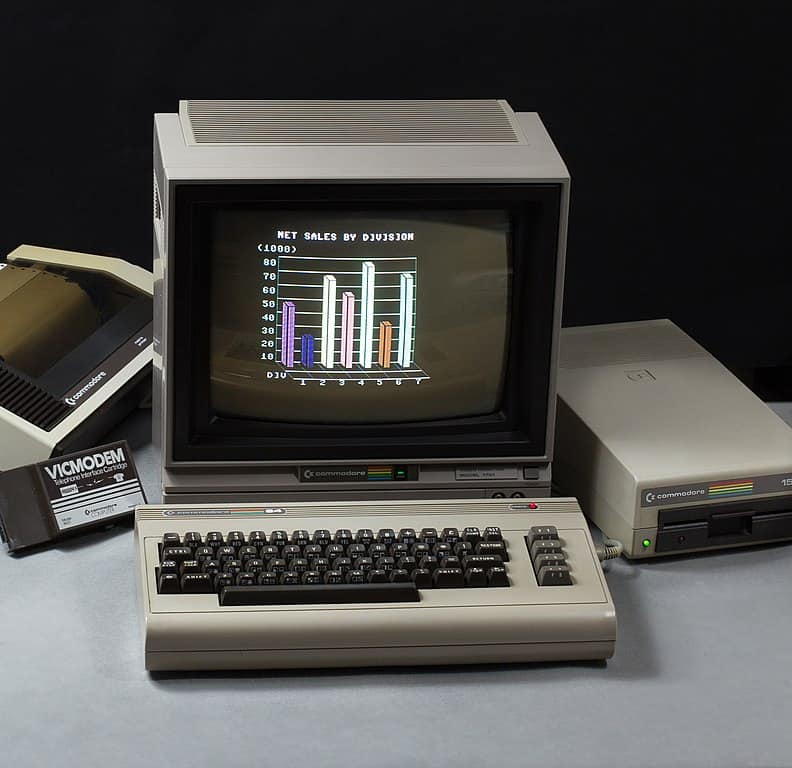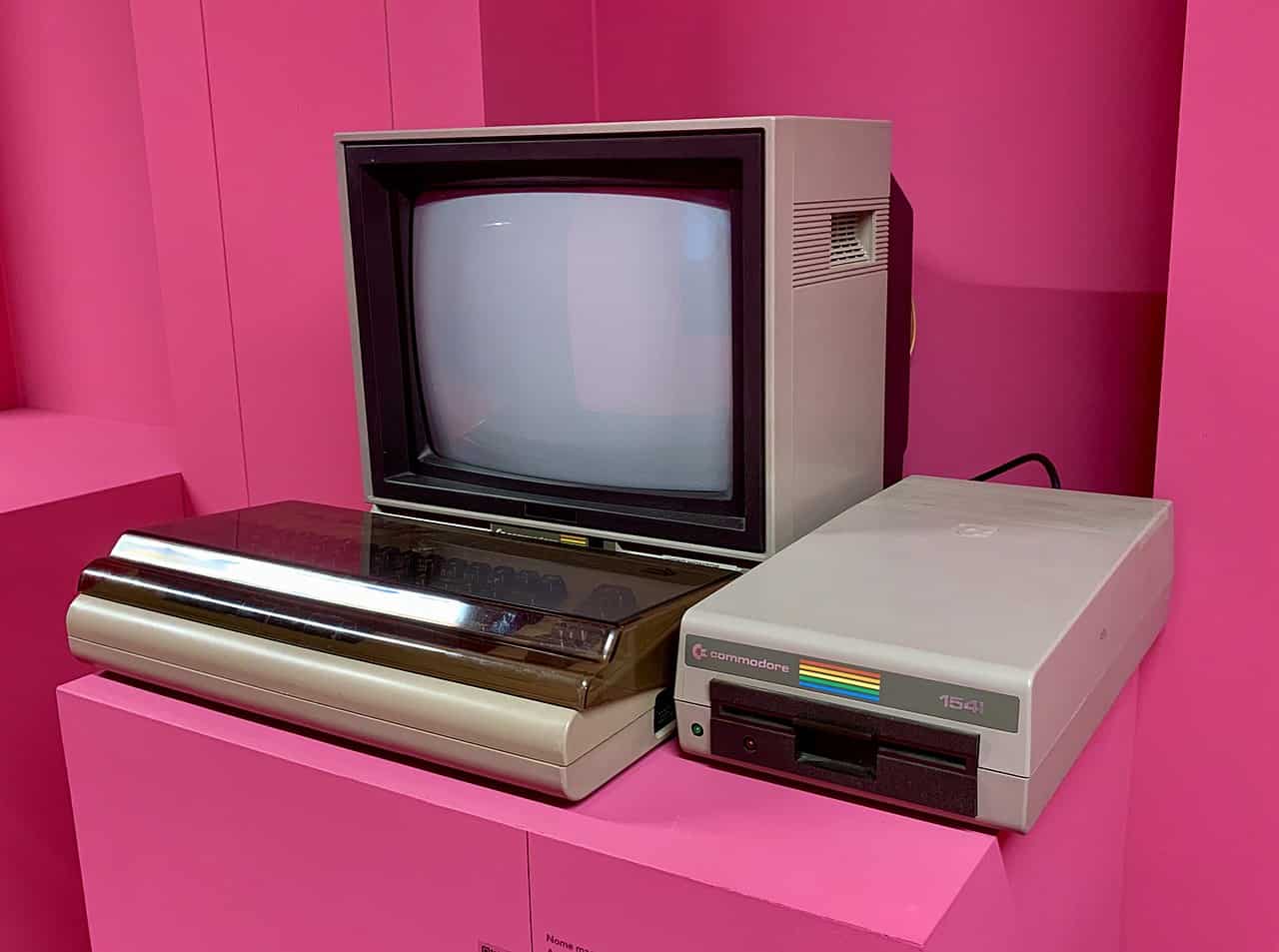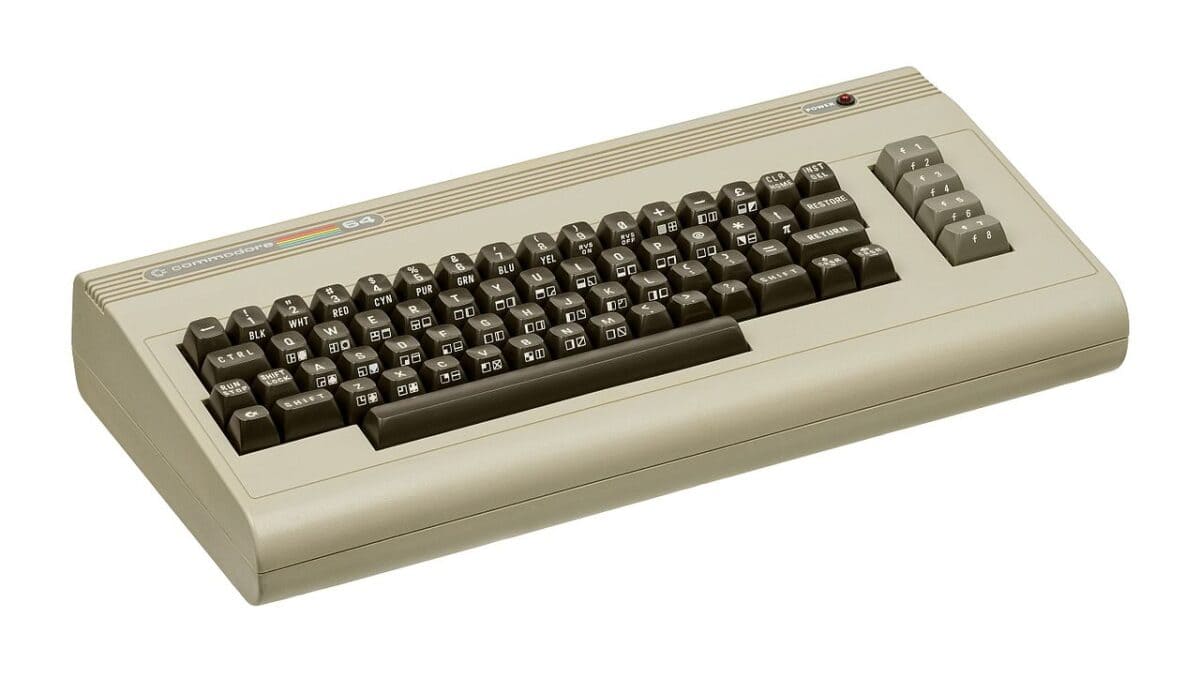Commodore 64 (commonly known as the C64 or CBM 64) was manufactured by Commodore Business Machine (CBM) in August 1982 with a starting price of $595. It was an 8-bit home computer with remarkable market success. Between 1983-1986, C64 sales amounted to about 17 million units sold, making them the best-selling single personal computer model of all time in 1983-1986.
Additionally, the Commodore 64 dominated the market with between 30% and 40% share and 2 million units sold per year, outselling the IBM PC clones, Apple Computers, and Atari computers. Adding to their success, Sam Tramiel (former Atari president), during an interview in 1989, said they were building 400,000 C64s a month for a couple of years.
Quick Facts
- Original price
- $595 (equivalent to $1,600 in 2021)
Unlike other computers, the C64 was sold in retail stores instead of electronic stores. Also, it had excellent specs, which enabled the C64 machines to plug into the existing home television without any modifications directly. Commodore 64 produced many of its parts in-house to control supplies and cost. It improved reliability and reduced manufacturing costs to about $25.00. Eventually, the consumer price of the CBM 64 dropped to around $200.00.
The Commodore 64 created approximately 10,000 commercial software titles, including Development Tools, Office Applications, and Games. The machine is also credited with popularizing the computer demo scene. Furthermore, the VICE software program (Versatile Commodore Emulator) gave the best experience running the C64 microcomputer functions. The C64 8-bit home computer is still in use today, and it’s possible to run on windows through the WinVICE emulator. However, Commodore 64 ended its production on 29 April 1994.
Facts about Commodore 64
- Tramiel named his business commodore following the involvement of Opel Commodore Car in the burgeoning personal computing field. The number 64 represents the commodore storage capacity of 64 kilobytes (KB) RAM.
- Tulip computers became the brand name owners Since September 1997. In July 2004, Tulip confirmed their products would be under the Commodore name.
- C64 supported multicolor sprites enabling it to create amazing visuals. Also, its Sound Interference Device (SID) chip produced great sounds.
- It has been listed in the Guinness Book of World Records as one of the best-selling single computer models of all time.
Commodore 64 Specifications
- Its operating system was Commodore KERNAL/Commodore BASIC 2.0.
- The CPU was MOS Technology 6510, working at 1.02 MHz (NTSC version) or 0.985 MHz (PAL version)
- Its dimension 40.4 (W) x 21.6 (D) x 7.5(H), Weighed 1820 g, Screen resolution 320×200 pixels, graphics Vic-II (320X200, 16 colors, sprites, raster interrupt), and the sound was SID 6581, three channels of sound.
- C64 ports: TV, RGB, composite Video, two joysticks, cartridge port, serial peripheral port. Peripherals: cassette recorder, printer, modem, external 170K floppy drive.
- C64 has a memory of 64 kB RAM, 20 kB ROM.
The History of Commodore 64
Before CBM 64 official release date (1982), The Commodore Business Machines had been founded in 1954 by Jack Tramiel (Jewish, born Idek Trzmiel on 13 December 1928, in Łódź, Poland, emigrant to the United States in 1947) of Bronx, New York. Later Tramiel relocated to Toronto and became the biggest manufacturer of low-cost office furniture in Canada. In the 1970s, Commodore manufactured calculators and digital watches but killed Texas Instruments. In 1976 Commodore purchased MOS Technologies, an American maker of IC chips. MOS’ senior engineer, Chuck Peddle, was working on the 6502 microprocessor, a famous 8-bit processor that soon would be used in machines like the Apple II, the Atari 800, the Commodore PET.

with monitor and floppy
©Adam Podstawczyński, CC BY 4.0, via Wikimedia Commons – Original / License
In 1977 Commodore launched its first successful microcomputer—PET 2001 computer, for US$600. In 1980 Commodore Japan introduced the VIC-1001 (later called the VIC-20 in the USA) for US$299, which appears to be a relatively good machine. During its life, production peaks at 9000 units per day.
In January 1981, MOS Technology worked to better the C64 specs and initiated a project to design the graphic and audio chips for a next-generation video game console. The Design work for the chips (which will be used in C64), named MOS Technology VIC-II (graphics) and MOS Technology SID (audio), was completed in November 1981. C64 also made the VICE emulator in order to better its user’s experience in all programs such as gaming and office applications.
At the same time, Robert Russell (system programmer and architect on the VIC-20) and Robert Yannes (engineer of the SID) were critical of the current product line-up at Commodore, which was a continuation of the Commodore PET line aimed at business users. With the support of Al Charpentier (engineer of the VIC-II) and Charles Winterble (manager of MOS Technology), they proposed to Commodore CEO Jack Tramiel a true low-cost sequel to the VIC-20.
Tramiel dictated that the C64 machine specs should include 64 kB of RAM. Although 64 KB of DRAM cost over 100 USD at the time, he knew that DRAM prices were falling and would drop to an acceptable level before reaching C64 full production. In November, Tramiel set a deadline for the first weekend of January to coincide with the 1982 Consumer Electronics Show.
The product was codenamed the VIC-40 as the successor to the popular VIC-20. The team that constructed it consisted of Bob Russell, Bob Yannes, and David A. Ziembicki. The team finished the design, prototypes, and some sample software in time for the show after the team had worked tirelessly over Thanksgiving and Christmas weekends.
The VIC-40 was renamed C64 during the presentation to fit the current Commodore business products lineup, which contained the P128 and the B256, both named by a letter and their respective memory size.
The C64 made an impressive debut at the January 1982 Winter Consumer Electronics Show, as recalled by Production Engineer David A. Ziembicki: “All we saw at our booth were Atari people with their mouths dropping open, saying, ‘How can you do that for $595?'” As it turned out, the answer was vertical integration; thanks to Commodore’s ownership of MOS Technology’s semiconductor fabrication facilities, each C64 had an estimated production cost of only $135.
In 1984, Commodore released the SX64 (see the upper image), a microcomputer C64 with a built-in monitor, floppy drive, power supply, and 40.4×21.6 dimensions.
The Public Response
Commodore 64 was the first to introduce the 8-bit single computer and made a great sale. During the time, CBM 64 first-quarter sales were $49 million, making them one of the largest home computer developers. Unlike other single computer model companies, the C64 was sold at a cheap price ($595) because they could cut the cost of production by creating their chip. Its low prices made a successful sale of approximately 17 million units.
Despite CBM 64 beautiful achievements, it never lasted long since its release date. CBM 64 announced bankruptcy In April 1994. According to Pleasance (ex-CEO of C64), Commodore failed because it lacked a consistent business plan. In addition, after the Commodore division with the Amiga operation, it ventured into the PCs business sold in Europe. However, it spent beyond limits in its Market expansion which led to its bankruptcy.
Next Up…
- Datapoint 2200: Everything You Need to Know
- CT-650 – History of the Arkay Computer Trainer Model 650
- Hewlett Packard 9100A: Everything You Need To Know
The image featured at the top of this post is ©Federigo Federighi, CC BY-SA 4.0, via Wikimedia Commons.









